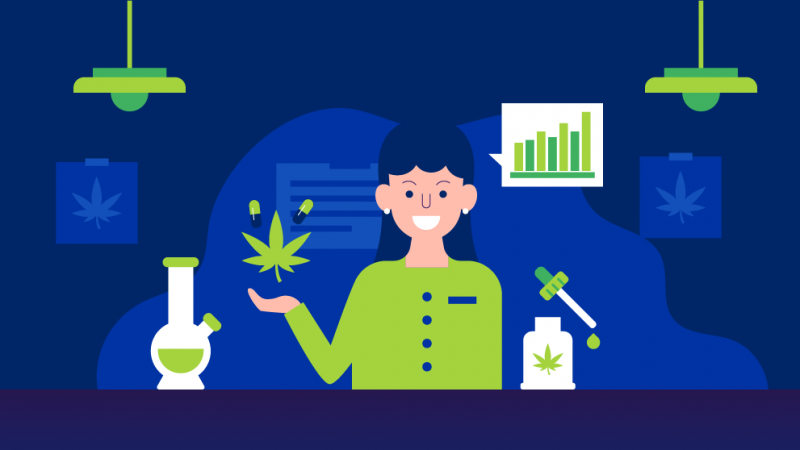100+ Must-Know Marijuana Statistics and Facts (Infographic)

Aren’t we living in exciting times? Marijuana statistics are changing so rapidly, it’s hard to keep up track! However, we hope we have succeeded in bringing you the most recent and important stats for 2022 (coronavirus facts included, I’m afraid).
We’re going to look at this magnificent and controversial plant from several angles. You’ll see just how many people in the world love using it, the head-spinning figures about the sales and revenues, disappointing criminal statistics, and many more.
Key Marijuana Statistics for 2022
- 52% of users use cannabis for recreational and medical purposes.
- The global cannabis market should reach $47 billion by 2025.
- California is the state with the highest number of medical marijuana patients — 2 million
- One marijuana bust happens every 58 seconds.
- Approximately 10% of people worldwide experience cannabis use disorder (CUD).
- Amidst the pandemic, 40.4% of Americans smoked marijuana once or twice a week.
- 68% of Americans are in favor of legalizing cannabis, marijuana statistics reveal.
- Some states witnessed a 20% increase in marijuana sales since the lockdown.
- Recreational marijuana sales witnessed a 159% growth in California amidst the pandemic.
- In 2020, Cannabis sales in the US increased by 67%.
In order for you to gain a better insight, we’ve collected a plethora of riveting stats and facts you have to know about, all neatly presented in this infographic. Let’s take a look!
Marijuana Use Statistics That Support Legalization
How many people use cannabis on a daily basis?
1. There were 263 million cannabis consumers around the world in 2019.
(GlobeNewswire)
However, with the word about its medicinal use spreading faster than ever and more approved scientific evidence, it’s only logical to witness an even bigger increase in the years to come.
2. Marijuana users statistics report 1 in 20 Americans over 55 smoke cannabis regularly.
(UPI)
About 5% of Americans aged 55 or older used marijuana or hashish the month before. The usage is higher among men (6.7%) than women (3.5%).
In addition to that, the highest increase in numbers was noted in the states where the use of recreational marijuana is legal.
3. 52% of users consume cannabis for recreational and medical purposes, marijuana statistics reveal.
(ICR)
Based on the 2020 Cannabis Consumer survey, 31% of people use cannabis for recreational reasons exclusively. 17% of Americans over 18 use cannabis strictly for medical purposes.
The biggest cannabis lovers are Millennials (44%), followed by Gen X (23%), Gen Z (20%), and Boomers (12%).
4. In 2018, marijuana was the most used illicit drug in the country, as recorded by the statistics on marijuana usage.
(DEA)
Not only is marijuana used in all 50 states, but it is illegally cultivated in all of them, too. Due to the large consumption and interest, a large amount of marijuana is (illegally) imported.
Mexico is the biggest marijuana supplier for the States. It’s also believed that this country will have the largest legal cannabis market in the world.
5. In 2019, 22% of young Americans reported smoking marijuana.
(Statista)
22% of Americans between the age of 18 and 29 are said to use marijuana, making this the age group with the largest percentage of marijuana smokers.
6. Marijuana rates by age confirm US seniors are the fastest-growing group of marijuana consumers.
(The Guardian)
Apparently, marijuana consumption is one area immune to ageism. Americans over 50 years old are more and more turning to alternatives to their prescribed medicines.
The legalization and appeal of marijuana products, such as vape pens, have inspired a more relaxed attitude among seniors towards marijuana use.
7. Flowers are the most preferred form of consumption for 68% of both recreational and medical cannabis users.
(ICR)
Marijuana facts and statistics show that CBD capsules (7%) are the least used products among recreational and medicinal cannabis users. They definitely prefer more traditional forms like flower (68%), pre-rolled joints (40%), and vaporizers (35%).
8. About 8% of Europeans report having used cannabis products.
(Prohibition Partners)
1 in 10 Europeans aged 15 and above (30 million people) reported using cannabis in 2019. The highest incidence of cannabis users was noted in Ireland, where, based on the marijuana usage stats, 17% of the surveyed used cannabis. That’s 1 in 5 people!
Next was Luxembourg with 16%, and Latvia with 14%. Greece (1%), Malta (2%), and Cyprus (2%) had the lowest prevalence of cannabis users.
9. Marijuana has a different effect on users regarding their gender.
(NIDA)
Men tend to get more “high”, whereas women are more prone to memory impairment. Also, women tend to feel an increased appetite more than men.
However, men are generally more interested in trying illicit substances than women, and therefore more prone to visiting emergency rooms.
Medical Marijuana Statistics
How many states have legalized medical marijuana? How many people use it and why?
10. In 1996, California became the first state to legalize medical marijuana.
(Medical Marijuana, Inc.)
More states have followed suit from then on, and the passing of the Farm Bill is a positive sign even more states will join.
One species of cannabis has been made legal (industrial hemp), but we are still waiting for marijuana to be approved on the federal level.
11. Medical marijuana is legal in 36 states, including the District of Columbia, as of April 2021.
(Statista) (Investopedia)
Medical marijuana facts and statistics vary from state to state. That is, the laws regarding the usage of medical marijuana can be quite distinctive.
For example, in Alaska, people can possess only one ounce of cannabis for medical or recreational use. Having four or more ounces will be considered a criminal offence.
36 states have legalized marijuana in one form or the other.
12. Medical marijuana helps 88.2% of Oregon patients deal with pain.
(Statista)
Medical marijuana is most commonly used for pain control and pain relief, although it can be used to treat other conditions.
Medical marijuana statistics imply that the biggest high percentage of Oregon patients use it for pain (88.2%). Much fewer people use it to treat spasms (21.6%), post-traumatic stress disorder (14.4%), nausea (10.2%), and cancer (6.3%).
13. California is the state with the highest number of medical marijuana patients — 2 million.
(Statista)
2 million Californian patients, or 4.86% of California’s population, have their medical cards and are allowed to use marijuana for treating their state.
If we look at percentages by state, the biggest percentage of medical marijuana patients resides in Oklahoma, California, and Maine.
14. Statistics on medical marijuana show it’s an effective treatment for epilepsy.
(Marijuana Doctors)
Unlike other medicines for epilepsy, which can cause serious side effects, medical marijuana has mild side effects. For example, medical marijuana can reduce seizures’ side effects like nausea, anxiety, headaches, jerking, or spasms.
On top of that, many studies show that it can reduce the frequency of seizures in epilepsy patients.
Marijuana Legalization Facts and Statistics
What can legalizing cannabis do?
15. Legalizing cannabis would cause financial issues for the American Congress.
(Motley Fool)
If all of the cannabis were legalized, that would cause a $5 billion reduction of cash flow for Congress in the next decade.
Namely, cannabis businesses are paying extremely high taxes. If cannabis was treated as any other legal substance, there would no longer exist the justification for such actions.
We still remember it was only in 2014 that the Rohrabacher-Blumenauer Amendment prohibited the US Department of Justice to use federal funds for discouraging states from implementing medical marijuana laws on their own.
16. 68% of Americans are in favor of legalizing cannabis, marijuana statistics indicate.
(Gallup)
The number of Americans who support marijuana legalization reached its record in 2020. If we take a look at the previous years, we can see a steady growing tendency towards legalizing cannabis.
17. 63% of Gen X support legalization.
(Marijuana Doctors)
Based on the most recent Gallup poll, 85% of Americans that are 18–35 years old support cannabis legalization. What is more, 12% of Baby Boomers declare themselves as daily cannabis users.
18. Marijuana statistics prove marijuana legalization actually decreases crime rates.
(Connecticut Criminal Lawyer)
For example, in Washington state, there was a decrease in the number of arrested individuals (over 21 years) due to marijuana possession by 98%. At the same time, Colorado witnessed a reduction in illegal possession, cultivation, and marijuana distribution by 85%.
As for the rest of the crime scene, no increases in crime rates were registered in states where marijuana was legalized.
19. Arizona, New Jersey, Montana, and South Dakota legalized marijuana in 2020.
(Addiction Center)
Marijuana legalization statistics changed for the better in 2020.
New Jersey was the first mid-Atlantic state that decided to legalize marijuana, while South Dakota was the first state that simultaneously legalized both medical and recreational marijuana.
Although people from South Dakota will be able to use medical and recreational marijuana, starting from July 1, 2021, there will still be developing rules and regulations until April 1, 2022.
Marijuana Crime Rates & Statistics
What can we learn from the crime statistics, and how are they linked to cannabis usage?
20. The War on Drugs was declared by President Nixon in 1971.
(The Guardian)
The War on Drugs was only a tool to deal with antiwar protests and associate hippies with cannabis use in order to arrest them more easily. Similarly, African American arrests were made more feasible by associating them with heroin usage.
21. Marijuana is the second most frequently found substance in drivers’ bodies after serious traffic accidents.
(Drug Free World)
Right next to alcohol, marijuana is the second most frequently found substance in the bodies of drivers involved in fatal automobile accidents.
According to Drug Free World marijuana statistics, if a driver involved in fatal car crashes has some kind of substance in their blood, it is most probably alcohol, but marijuana is a close second.
22. In the US, marijuana is regarded as dangerous as heroin or LSD.
(DEA)
Marijuana is enlisted as a Schedule 1 drug. The US Drug Enforcement Administration (DEA) still holds the opinion that marijuana (especially the indica species) has no currently accepted medical use and is prone to substance abuse.
23. Marijuana incarceration rates show one marijuana bust happens every 58 seconds.
(Marijuana Moment)
Despite the legalization efforts, the number of arrests is only getting higher. Out of all the drug arrests in the USA in 2019, 35% were linked to marijuana.
In other words, out of 545,601 arrests that were linked to marijuana in 2019, 92% of them were associated with marijuana possession.
Marijuana arrests statistics also report the northeast witnessed the highest number of arrests, where 53% of all drug arrests were linked to marijuana.
24. African Americans are more likely to get arrested for marijuana possession.
(The Baltimore Sun)
The harsh racial disparity is even more shocking if you know the fact there is no data confirming African Americans are larger consumers of marijuana than any other minority or majority.
25. In 2019 there were 49 cannabis-involved fatalities in Colorado, marijuana car accidents statistics report.
(CDOT)
These traffic accidents involved drivers who had 5 nanograms of THC in their blood or greater of Delta-9 THC. Likewise, the rates of traffic deaths went up by 25% in 2019, compared to 2013, when it was up by 15%.
Based on the reports, Millenials are most likely to drive under the influence of marijuana (14%), as well as Gen Z (10%). The percentage is also higher among men (8%) than women (5%).
Marijuana Addiction Statistics
Can you become addicted to marijuana?
26. Cannabis is less addictive than alcohol and opioids.
(Harvard Gazette)
According to Kevin Hill, associate professor of psychiatry at Harvard Medical School and director of the Division of Addiction Psychiatry, the main issue is the lack of the right education that would diminish the chances of cannabis use disorder (CUD).
Consequently, the less addictive nature of cannabis and uncertainty about the right dosage, as well as the fact that it can affect people in a different way, can cause serious issues.
27. A twin study from 2019 confirmed that marijuana usage does not cause a drop of 8 IQ points.
(Leafly)
The infamous long term effects of marijuana usage were denied in the latest research.
The 2019 study compared 428 twin pairs and found no scientific evidence for the previous claim. As a matter of fact, the only drops in intelligence occurred in both twins — the one that was using marijuana, and the other who wasn’t.
28. Marijuana addiction rates show approximately 10% of cannabis users worldwide experience cannabis use disorder (CUD).
(PubMed)
CUD is one of the most serious long-term side effects of marijuana’s usage.
The main CUD symptoms include craving for cannabis, problems in controlling its usage, using cannabis in high-risk situations, using cannabis despite psychological or physical problems, etc.
In addition to that, CUD can have mild (2-3 symptoms), moderate (4-5 symptoms), and severe (6 and more) symptoms.
29. In the US, 30% of cannabis users are estimated to may have some symptoms of CUD.
(NIDA)
Marijuana usage statistics imply that this syndrome is more frequent among regular cannabis users and people with substance use disorders.
Also, those who start using cannabis before the age of 18 are at a much higher risk of developing CUD — up to seven times more likely.
30. Marijuana is not a gateway drug.
(NIDA)
Marijuana gateway drug statistics tell us that even though people using marijuana may turn to drug abuse, there is no uniform tendency. Otherwise, it could be said for alcohol to be a gateway substance, too.
31. Smoking marijuana can increase the heart rate for up to 3 hours afterward.
(NIDA)
Among other marijuana side effects are impaired memory and movement, altered senses, moodiness, difficulty in problem-solving and thinking.
32. Marijuana is not safe for pregnant women.
(Today’s Parent)
Despite the fact that marijuana is very helpful for reducing nausea, smoking marijuana during pregnancy statistics confirm marijuana is not recommendable during pregnancy.
It can reduce the oxygen flow to the baby, make the placenta more penetrable and allow for a part of the THC content to harm the baby.
33. There are no marijuana death rates to report as no one has ever died of a marijuana overdose.
(Drug War Facts)
Among a plethora of substance abuse deaths, there still hasn’t been a single case recorded in the US in which a person died due to a marijuana overdose.
Marijuana and COVID-19 Statistics
How did the pandemic impact marijuana sales?
34. Amidst the pandemic, 40.4% of US cannabis consumers smoked marijuana once or twice a week.
(Statista) (Statista)
28.7% smoked one gram or less every day, 24.6% smoked marijuana once or twice a month, and 13.7% smoked 2 grams or more every day.
Likewise, marijuana statistics show coronavirus was responsible for the increased cannabis usage among Americans.
The highest increase was noted among Millennials. 40% planned to use cannabis more often amidst the pandemic. Gen X members were not so sure (31%). Gen Z (29%) claimed the same.
35. About 59% of Americans found marijuana more appealing than alcohol because weed doesn’t leave you with a bad hangover.
(Statista)
Moreover, 43.2% reported they would rather smoke weed than drink alcohol because marijuana impact feels better than alcohol, marijuana vs alcohol statistics show.
36. About 26.19% of Americans find marijuana to be more effective than anxiety relief supplements.
(Statista)
Based on one 2020 survey, about 26.19% of cannabis users who started using anxiety relief supplements (when the pandemic started) declared that marijuana had better results in fighting anxiety.
37. Some states witnessed a 20% increase in marijuana sales since the lockdown, stats on marijuana sales show.
(Banyanmass)
Edibles were the most purchased cannabis products. In fact, the daily sales went up by a whopping 28%. Many people used marijuana during the lockdown to help them deal with covid-related stress and anxiety.
38. Recreational marijuana sales witnessed a 159% growth in California amidst the pandemic.
(Statista)
The 2020 March statistics show us that recreational marijuana was in incredibly high demand. The sales skyrocketed in Washington state by about 100%. Colorado marijuana sales went up by 46% on March 16, 2020.
Marijuana Business Statistics
How big is the cannabis market, and what do the future predictions tell us?
39. The most expensive marijuana is sold in the District of Columbia.
(Statista)
For 1 ounce of pleasure or medicine, you will have to pay $591.42 on average.
The next in line and with a much lower price is Illinois, with the price of $352.13. Oklahoma follows with $342.21. For the best marijuana deal, head over to Oregon and pay only $209.99 per ounce.
40. The global cannabis market should reach $47 billion by 2025.
(PR Newswire)
Statistics of marijuana’s 2019 global market show the legal cannabis sales experienced a 46% growth in 2019, reaching the figure of an astounding $14.8 billion. In the same year, US sales also witnessed an increase of 37%, reaching $12.4 billion.
41. There was a growth in senior-level cannabis wages in 2020.
(Flowhub)
Based on the survey conducted by Vangst, the average wages for retail roles became higher in 2020. For example, the average pays for dispensary general managers went up by 13%, while the salaries for directors of retail operations went up by 22%.
42. The current MJNA stock price is $0.0522.
(Wallet Investor)
According to financial experts, things are not looking up for the holding company this year. Medical Marijuana, Inc. will probably experience some hardships in 2021.
43. In 2020, Cannabis sales in the US increased by 67%.
(Ganjapreneur)
The sales of both recreational and medical marijuana witnessed an immense increase in 2020, reaching a total of $17.9 billion.
Some states even doubled their sales in 2020, like Connecticut, Maine, Ohio, and Florida, marijuana business statistics reveal.
44. 2020 was a record year for Colorado cannabis sales. The annual sales witnessed a growth of 25%.
(The Denver Post)
Based on the available data, Colorado dispensaries managed to sell $186,343,208 worth of cannabis products in December alone while collecting almost $32.4 million in fees and taxes. The total of Colorado sales for 2020 was a mind-blowing $2,191,091,679.
What’s more, marijuana flower was one of the most popular products, which accounted for 48.2% of all purchases, followed by vaporizer pens (16.2%), Colorado marijuana statistics report.
45. $60 billion is the annual revenue from illegal marijuana in the US.
(Leafly)
This is the estimated figure for 2020, as illegal markets don’t really report their revenues. Either way, the figure is much higher than the $23 billion spent on legal cannabis in the same year.
46. Marijuana stats for 2019 recorded that Americans spent more on cannabis than on toothpaste, sleep aids, and hard seltzer.
(U.S. News)
Indeed, Americans loved spending more money on cannabis than these three items altogether. Over-the-counter sleep aids are not as popular as cannabis and CBD oil to take care of sleep disorders.
47. In April (2020), Colorado issued 40,267 individual marijuana licenses and 1,686 business owners licenses.
(Medical Marijuana Inc.)
Colorado after legalization statistics show that about 19,592 people are employed in the state’s cannabis industry which makes Colorado one of the biggest marijuana job markets.
48. The highest marijuana sales in 2020 were on New Year’s Eve, reaching a whopping $89.4 million.
(PR Newswire)
While the most famous cannabis sale day was 4/20 day, things were quite different in 2020. The highest cannabis sales were reached on New Year’s Eve. That’s followed by Green Wednesday ($87.4 million) and Wednesday before Christmas ($87.4 million).
The most popular shopping day, Black Friday brought in “only” $86 million. Last but not least, marijuana usage statistics state Friday before Halloween cashed in $85.8 million.
Conclusion
Marijuana is no longer reserved for hush-hush talks, but informed, open discussions – no matter if you are a cannabis supporter or not.
On the one hand, federal law does not make a difference between marijuana and LSD, and marijuana possession arrests are still very frequent (especially for a certain part of the population).
On the other hand, statistics on marijuana supporting its health benefits helped turn it into a prescribed medicine besides being a relaxation aid.
Nevertheless, recreational or not, marijuana usage is not to be taken lightly. The attitude towards marijuana is changing on the federal level as you are reading this so we can expect some more exciting stats to arrive on our pages soon enough.
Without a doubt, marijuana statistics will continue to amaze and shock us, so stay tuned!








